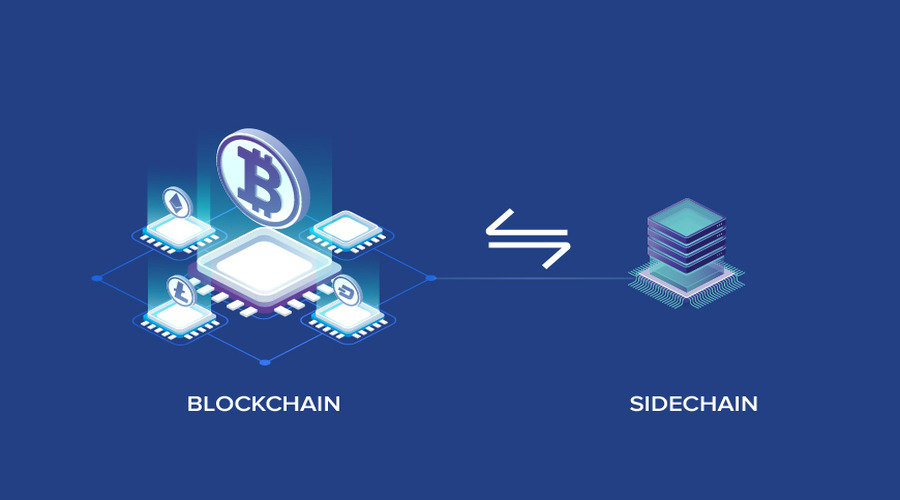Blockchain technology has revolutionized the way we think about data storage and trust in digital transactions. As this technology continues to evolve, new advancements are being made to expand its functionality and address some of its limitations. One such advancement is the concept of sidechains, which provide an additional layer of flexibility and scalability to blockchain systems. In this article, we will explore the world of sidechains, their types, use cases, challenges, and potential impact on the blockchain ecosystem.
Introduction
In the realm of blockchain technology, sidechains act as an extension to the main blockchain, offering new features and functionalities that enhance its overall capabilities. These sidechains operate alongside the primary blockchain, enabling developers to experiment with new ideas without risking the security and stability of the main network. Sidechains work by establishing a connection or “two-way peg” between the main blockchain and the sidechain, allowing for the transfer of assets and data between the two.
Layering is a fundamental concept in blockchain design. It involves the division of complex systems into modular components, each responsible for specific functions. Sidechains are a prime example of layering, as they introduce an additional layer to the blockchain architecture, expanding its capabilities while maintaining the core integrity of the main network.
Understanding Sidechains
- Definition and purpose of sidechains
Sidechains can be defined as separate blockchains that run parallel to the main blockchain and are interoperable with it. They allow for the creation and execution of smart contracts and other decentralized applications (dApps) that may have different rules or requirements compared to the main blockchain. The purpose of sidechains is to address scalability, privacy, and functionality limitations of the main blockchain while still benefiting from its security and decentralization.
- How sidechains work and their relationship with the main blockchain
Sidechains operate by employing a two-way peg mechanism, which enables assets to be securely transferred between the main blockchain and the sidechain. This pegging process ensures that the assets locked in the main chain are released when they are transferred to the sidechain and vice versa. By establishing this connection, sidechains can maintain a link to the main blockchain, allowing for interoperability and seamless asset transfer.
- Advantages of using sidechains in blockchain systems
Sidechains offer several advantages that make them a valuable addition to the blockchain ecosystem. Firstly, they provide scalability solutions by offloading certain transactions or dApps to the sidechain, reducing the congestion on the main blockchain and increasing its capacity. Secondly, sidechains enable interoperability between different blockchains, allowing for seamless asset transfer and data exchange across multiple networks. Furthermore, sidechains can enhance privacy by implementing specific protocols that ensure sensitive information remains confidential. Lastly, sidechains introduce new functionalities and smart contract capabilities that may not be feasible or compatible with the main blockchain.
Types of Sidechains
- Two-way pegged sidechains
Two-way pegged sidechains are the most common type of sidechains. They establish a link between the main blockchain and the sidechain, enabling assets to be transferred back and forth. This type of sidechain ensures the security and integrity of the assets, as they can only be released on the main chain when the corresponding assets are locked in the sidechain.
- Federated sidechains
Federated sidechains rely on a group of trusted entities or validators to manage the transactions and consensus on the sidechain. This approach can provide faster transaction processing times and increased scalability. However, it introduces a certain level of centralization, as the validation process is controlled by a limited number of entities.
- Drivechain sidechains
Drivechain sidechains aim to achieve a higher level of decentralization by using the main blockchain’s hash power to secure the sidechain. This method allows for greater security and avoids relying on a federated group of validators. Drivechain sidechains offer a balance between security and decentralization, making them an attractive option for developers.
- Hybrid sidechains
Hybrid sidechains combine elements from different types of sidechains to leverage their individual advantages. For example, a hybrid sidechain might use a two-way peg mechanism for asset transfer while incorporating a federated consensus model for transaction processing. This flexibility allows developers to tailor the sidechain architecture to meet specific requirements.

Use Cases for Sidechains
- Scalability solutions
One of the main challenges facing blockchain technology is scalability. Sidechains provide an effective solution by offloading transactions and dApps to separate chains, relieving the congestion on the main blockchain. By distributing the workload, sidechains can significantly increase the transaction throughput and improve overall system performance.
- Interoperability between different blockchains
Interoperability is crucial for the widespread adoption and integration of blockchain systems. Sidechains act as bridges between different blockchains, enabling the seamless transfer of assets and data across multiple networks. This interoperability facilitates collaboration between different blockchain communities and opens up new possibilities for cross-chain applications.
- Privacy enhancements
Privacy is a concern in many blockchain applications, especially those involving sensitive data. Sidechains can implement specific privacy protocols, such as zero-knowledge proofs or ring signatures, to ensure confidential transactions and data privacy. By segregating sensitive information to a sidechain, users can enjoy enhanced privacy without compromising the transparency and security of the main blockchain.
- Smart contract functionality
Smart contracts are a core feature of blockchain technology, enabling self-executing agreements without the need for intermediaries. Sidechains can introduce new smart contract functionalities and capabilities that may not be supported by the main blockchain. Developers can experiment and deploy specialized smart contracts on sidechains, providing tailored solutions for specific use cases.
Challenges and Limitations of Sidechains
- Security considerations
Sidechains introduce additional attack vectors and potential security risks. Ensuring the security of the two-way peg mechanism is crucial to prevent double-spending or unauthorized asset transfers. Robust security measures, such as cryptographic techniques and auditing processes, must be implemented to mitigate these risks effectively.
- Potential centralization risks
Certain types of sidechains, such as federated sidechains, may introduce centralization risks. Relying on a limited number of validators or trusted entities can lead to a concentration of power, potentially compromising the decentralized nature of blockchain technology. Striking a balance between scalability and decentralization is essential to maintain the integrity of the overall system.
- Governance and consensus mechanisms
Sidechains may require different governance and consensus mechanisms compared to the main blockchain. Ensuring effective coordination and decision-making within the sidechain ecosystem is crucial for its successful operation. The design and implementation of governance models that align with the specific needs of each sidechain are vital for long-term sustainability.
- Integration with existing blockchain protocols
Integrating sidechains with existing blockchain protocols can be a complex task. Ensuring compatibility and seamless interaction between the main blockchain and the sidechain requires careful design and coordination. Protocol upgrades, cross-chain communication standards, and backward compatibility must be considered to facilitate efficient integration.
Examples of Sidechain Implementations
The Liquid Network
The Liquid Network, developed by Blockstream, is one of the most prominent examples of a sidechain implementation. It is designed to enhance the capabilities of the Bitcoin blockchain, providing faster transaction settlement and confidential asset transfer. The Liquid Network enables users to issue and trade digital assets securely, making it an attractive solution for exchanges and institutional players.
RSK (Rootstock)
RSK is a sidechain platform that brings smart contract functionality to the Bitcoin network. By extending Bitcoin’s capabilities with a Turing-complete virtual machine, RSK allows developers to build decentralized applications and execute complex smart contracts. RSK aims to leverage the security and robustness of the Bitcoin blockchain while providing additional features for the development of the decentralized finance (DeFi) ecosystem.
Ardor
Ardor is a blockchain platform that utilizes a unique parent-child chain architecture. It combines the security of a main chain with the flexibility of multiple interconnected sidechains, known as child chains. Ardor’s design enables businesses and developers to create their own customizable child chains, tailored to specific use cases, while benefiting from the security provided by the main chain.
Loom Network
The Loom Network is a platform that focuses on scalability and interoperability for blockchain applications. It utilizes sidechains to provide high-performance dApp development and integration with various blockchains, including Ethereum, TRON, and Binance Smart Chain. Loom Network’s sidechains allow for efficient scaling of decentralized applications and enable seamless interaction between different blockchain ecosystems.
Future Developments and Potential Impact
The field of sidechains is continuously evolving, with ongoing research and development aimed at improving their capabilities and addressing existing challenges. Advancements in sidechain technology may lead to increased scalability, enhanced privacy features, and improved interoperability between blockchains. The potential impact of sidechains extends beyond the realm of cryptocurrencies and has implications for various industries, including finance, supply chain management, healthcare, and more.
Conclusion
Sidechains play a vital role in extending the functionality of blockchain technology. By offering scalability solutions, enhancing interoperability, improving privacy, and enabling new smart contract capabilities, sidechains provide a flexible framework for innovation and development within the blockchain ecosystem. However, challenges such as security risks, potential centralization, governance models, and integration complexities must be carefully addressed. As sidechain technology continues to mature, its impact on various industries and the overall blockchain ecosystem is expected to grow significantly.
FAQs
- What is a sidechain in blockchain technology? A sidechain is a separate blockchain that runs parallel to the main blockchain and is interoperable with it. It provides additional features and functionalities that extend the capabilities of the main blockchain.
- How do sidechains work? Sidechains work by establishing a connection or “two-way peg” between the main blockchain and the sidechain. This allows for the secure transfer of assets and data between the two chains while maintaining interoperability.
- What are the advantages of using sidechains in blockchain systems? Sidechains offer several advantages, including scalability solutions, interoperability between different blockchains, privacy enhancements, and the ability to introduce new smart contract functionalities.
- What are the challenges of implementing sidechains? Security considerations, potential centralization risks, governance and consensus mechanisms, and integration with existing blockchain protocols are some of the challenges associated with implementing sidechains.
- What are some examples of sidechain implementations? Examples of sidechain implementations include the Liquid Network, RSK (Rootstock), Ardor, and the Loom Network. These projects demonstrate the diverse applications and potential of sidechains in the blockchain ecosystem.

